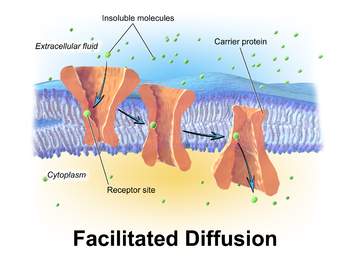Facilitated diffusion
Facilitated diffusion (also known as facilitated transport or passive-mediated transport) is the process of spontaneous passive transport (as opposed to active transport) of molecules or ions across a biological membrane via specific transmembrane integral proteins.[1] Being passive, facilitated transport does not directly require chemical energy from ATP hydrolysis in the transport step itself; rather, molecules and ions move down their concentration gradient according to the principles of diffusion.

Facilitated diffusion differs from simple diffusion in several ways:
- The transport relies on molecular binding between the cargo and the membrane-embedded channel or carrier protein.
- The rate of facilitated diffusion is saturable with respect to the concentration difference between the two phases; unlike free diffusion which is linear in the concentration difference.
- The temperature dependence of facilitated transport is substantially different due to the presence of an activated binding event, as compared to free diffusion where the dependence on temperature is mild.[2]

Polar molecules and large ions dissolved in water cannot diffuse freely across the plasma membrane due to the
Glucose, sodium ions, and chloride ions are just a few examples of molecules and ions that must efficiently cross the plasma membrane but to which the lipid bilayer of the membrane is virtually impermeable. Their transport must therefore be "facilitated" by proteins that span the membrane and provide an alternative route or bypass mechanism. Some examples of proteins that mediate this process are glucose transporters, organic cation transport proteins, urea transporter, monocarboxylate transporter 8 and monocarboxylate transporter 10.
In vivo model of facilitated diffusion
Many physical and biochemical processes are regulated by diffusion.[3] Facilitated diffusion is one form of diffusion and it is important in several metabolic processes. Facilitated diffusion is the main mechanism behind the binding of Transcription Factors (TFs) to designated target sites on the DNA molecule. The in vitro model, which is a very well known method of facilitated diffusion, that takes place outside of a living cell, explains the 3-dimensional pattern of diffusion in the cytosol and the 1-dimensional diffusion along the DNA contour.[4] After carrying out extensive research on processes occurring out of the cell, this mechanism was generally accepted but there was a need to verify that this mechanism could take place in vivo or inside of living cells. Bauer & Metzler (2013)[4] therefore carried out an experiment using a bacterial genome in which they investigated the average time for TF – DNA binding to occur. After analyzing the process for the time it takes for TF's to diffuse across the contour and cytoplasm of the bacteria's DNA, it was concluded that in vitro and in vivo are similar in that the association and dissociation rates of TF's to and from the DNA are similar in both. Also, on the DNA contour, the motion is slower and target sites are easy to localize while in the cytoplasm, the motion is faster but the TF's are not sensitive to their targets and so binding is restricted.
Intracellular facilitated diffusion
Single-molecule imaging is an imaging technique which provides an ideal resolution necessary for the study of the Transcription factor binding mechanism in living cells.
Facilitated diffusion of proteins on Chromatin
The in vivo model mentioned above clearly explains 3-D and 1-D diffusion along the DNA strand and the binding of proteins to target sites on the chain. Just like prokaryotic cells, in
For oxygen
The oxygen affinity with
For carbon monoxide
Facilitated diffusion of carbon monoxide is similar to that of oxygen. Carbon monoxide also combines with hemoglobin and myoglobin,[12] but carbon monoxide has a dissociation velocity that 100 times less than that of oxygen. Its affinity for myoglobin is 40 times higher and 250 times higher for hemoglobin, compared to oxygen.[13]
For glucose
Since glucose is a large molecule, its diffusion across a
